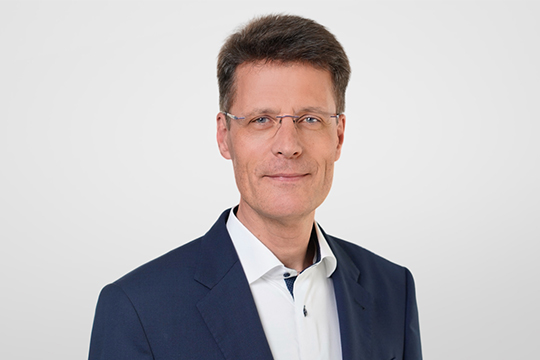The mode in which someone works is very important to Jörg Holleck. For the Division Manager Application Management at Rhenus, however, the decisive factor for the long-term success of his teams is above all the right mindset. He explains exactly what this looks like and what experiences he has had in software development with five Scrum teams in an interview with Detecon partner Dr. Roland Keil.
Detecon: Agility is currently on everyone's lips. What do you think: How many employees in your area are familiar with the Agile Manifesto for Software Development from 2001 and how many shape their everyday work accordingly?
Jörg Holleck: Our employees are all certified. When we started a good two years ago with a small team of twelve employees, we made it a point that if we wanted to work agilely with Scrum in execution, we would also train everyone to be a Scrum Master or Product Owner. This is important so that everyone knows what we are talking about and not everyone follows their own interpretation.
In our opinion, however, the mindset always comes before the framework, because ultimately it affects many areas: We select new employees according to the mindset whose principles we ourselves stringently work by. In addition to treating each other with respect, this also includes a commitment to accepting responsibility and an open culture of error.
What fascinates you personally about agility?
The above-mentioned interaction between employees is a decisive success factor for us. Furthermore, we are enthusiastic about the experience of continuous deliverability, which is guaranteed by the early and constant involvement of the customer in the development process. Regular communication with the client leads to a high level of transparency regarding all activities, which helps to avoid problems caused by a lack of or poor communication.
We observe that agile methods are often used without considering in advance which specific issues they are intended to address. What challenges would you like to address at Rhenus with agile methods?
The close cooperation with the clients. The improvements we were able to achieve here were an extremely positive benefit for us. In the close collaboration, both sides develop an understanding for each other: You discuss together what is being implemented, and you also discover together if something important has been forgotten.
In the past, errors were often sought in software development, while the client retreated to the position that he had communicated his requirements comprehensively and completely. Today, it is more obvious when the client forgets something or makes a mistake.
Transparency here creates enormous clarity and, above all, understanding for each other. This also applies to late changes to requirements - previously a "no-go" in the waterfall methodology, now we can react to such things in the shortest possible time within a sprint. Our clients also find this very positive.
Do you perhaps have a concrete example of this?
At the beginning of a request, we are faced with the decision: "Buy versus Build". Experience with external service providers has shown that, in some cases, experts are provided at the beginning of a project who drive the development well. As the project progresses, the contact persons change, so that the cooperation then no longer works so well.
We implemented the Rhenus Event Manager as the first project with a consistently agile approach on behalf of our HR department. Changes to the requirements often arose during the development process according to the motto: "The appetite comes while eating".
In this process, our developers were able to make constructive suggestions, which represented a gain in efficiency for the client. At any time, it was possible to fall back on the entire technical and professional competence! Due to the agile way of working, the clients are sometimes put under pressure in a positive sense, in that they have to formulate their requirements quickly and concretely.
Thus, both parties determine the speed today. Collaboration becomes more time-consuming because it is more concrete, as work packages are discussed until they are feasible.
Working with agile methods is a craft - the transformation to an agile organization is an art. What experiences have you had with agile organization at Rhenus?
We are organized in four pillars, but work with five Scrum teams. Agile working is ultimately not reflected in the organizational form. We believe that the complete management of an agile organizational unit cannot be handled exclusively with the roles Scrum Master, Product Owner and Development Team. All pillars are interdependent and interconnected.
So we have to find an organizational form that communicates with each other in a network structure - and that also on a higher level. Each Development Team cannot work exclusively autonomously, as there are almost always time as well as technical dependencies on the other teams.
In addition, employees would like to have disciplinary leadership that takes care of organizational and administrative issues. And some employees deliberately do not want to take on leadership responsibilities.
To structure a growing organization, Scaled Agile Framework (SAFEe) might be one approach. SAFe ultimately brings back a certain hierarchy, which is very personnel-intensive and, above all, time-intensive. An agile organization with flat hierarchies is to be strived for, but should not lead to a complete abandonment of hierarchies.
Our challenge lies in the fact that we organize four technically different areas in the form of five Scrum teams. Since similar qualifications are needed in each Scrum team, the area can ultimately be organized in a network structure. A positive example is the "Spotify Model". In this model, the professionalism (Chapter) on the one hand and the relationship to the clients as well as the effects of the interactions of the requirements (Tribe) on the other hand are used as an ordering criterion.
Who decides here?
Ultimately, it is the manager who decides on organizational and administrative aspects. Technical decisions are essentially made by the teams. The manager is called in when fundamental alignments require coordination - analogous to Jürgen Klopp, who says that everyone plays better soccer on the field than he does, and his responsibility is how to play.
At Rhenus, we take a fundamentally quite pragmatic approach here. In this sense, we have always worked very agilely here. You can try out a lot, little plants are encouraged until they grow. And if they don't develop, we have the courage to quickly stomp them out again.
This makes work very entertaining and is probably one reason why many employees enjoy working here and have been doing so for a long time, and why they basically have a certain mindset. Now we've just put all that into a more official form and filled it with defined roles.
How does what you live fit in with Rhenus' corporate values?
What we live fits very well with the Rhenus corporate values! Entrepreneurial spirit, for example, is one of the Rhenus values. It fits in with the fact that we have set up the structures in a very contemporary and professional manner. But entrepreneurial spirit also means employee loyalty.
On the one hand, we can use the agile way of working here as a selling point for new hires, because no one wants to work any differently in software development today. On the other hand, employees appreciate this way of working, which is ultimately reflected in very low staff turnover.
Continuity also plays a major role in the Rhenus Group: we are constantly improving our services, delivering continuously and are also focused on long-term relationships with our customers. Added to this are integrity, appreciative dealings, customer-focused solutions, regardless of whether they are for internal or external customers - the values that our Board of Management sets out are great to carry and implement as an employee here.
If you were to come to a new company tomorrow and introduce agility into software development, what would you start with?
First, the theoretical foundations should be laid so that everyone knows what is involved and the mindset and terminology are clear. An easy introduction can then be carried out on the basis of a pilot.
It's not a case of "Here's the Scrum Master and he'll explain the world to you now", but rather we use a small project as a starting balloon to check how it's developing. With the first experiences improvements can be made and considered in the further procedure. In this way, we are able to make continuous adjustments.
Currently, all five Scrum teams work very differently. Starting with a different number of team members to a very different number of topics to different lengths of iteration steps.
Is it enough to introduce agility in software development alone, or does this not necessarily involve other areas of IT and the business units?
The mindset is also extremely important in other areas. Promoting the agile mindset is of great benefit to all areas and levels, because it allows the best customer-oriented solution to be created quickly and continuously. And in the end, that doesn't always have to be software. The willingness to hand over responsibility and to trust employees to basically give their best is one of the prerequisites for this.
What do employees need to be provided and empowered with in order to work in an agile manner?
Leading by example is the be-all and end-all. It is important for me to remain calm even in difficult situations and to analyze what a solution might look like. In addition, helpfulness is important in our team. After all, it's not about insisting on one's rights, but finding the best solution for the customer.
When recruiting employees, Rhenus generally puts the personality as well as the attitude and motivation of an applicant first. Openness, flexibility and experience are a good mix - and the basis for a long-term and successful cooperation.
The understanding of responsibility is also relevant: One always has responsibility for one's actions. Everyone should be deployed according to their abilities. This is necessary and desired in a cross-functional team.
The more complicated it gets, the more you need a team, for example in the form of the four-eyes principle in software development. In the case of simpler activities, it is possible that no one checks more, but the greater the responsibility for the person who takes on the activity.
How do you motivate employees in your area to organize themselves without losing sight of the company's goals?
The way agile works is highly transparent. Of course, there are also conflicts. As a matter of principle, these are addressed within the team in retrospect and cleared out of the way.
If necessary, we at Rhenus support our employees by moderating conflict discussions in an open and appreciative manner. Everyone makes mistakes sometimes, but it is important to talk about them promptly and find a solution. If necessary, also together with the customer, if the situation requires it. We attach great importance to good communication.
Where did agility just get in your way?
I can't really give you any personal experience in response to this question. Because agile creates so much transparency, people often think it is the problem - but in the end, it only exposes the real problem.
Where do you get your motivation to set out on the path of agile transformation so consistently?
Even if it sounds very pathetic: Agility makes the working world a better place. We live in a VUCA (Volatility, Uncertainty, Complexity, Ambiguity) world, we have to react quickly, act openly and courageously, and always ask ourselves whether we are still on the right track. If not, there is always the possibility to develop further.
Trust, as well as all the other values behind agile working, are important in this. Satisfied employees and solutions that really help the customer are two of the most important motivators.
If the "fairy godmother of agility" showed up at your office tomorrow and gave you three wishes, what wishes would you name?
The entire organization should work agilely. However, the fee should also take into account that people need support - they find the framework for this, at least in part, in hierarchies. This aspect is very important to us at Rhenus.
Thank you so much for these insights!







